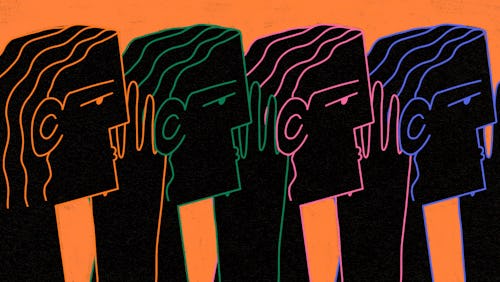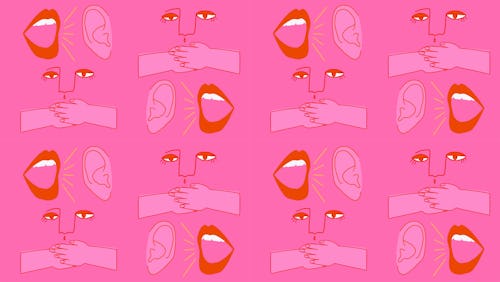
During the past two years of upheaval, many of us have learned a lot about the importance of our mental health. It was a lot easier to ignore our emotional ups and downs when we could go out all the time without fear for our lives, blissfully repressing our issues. A lot of us learned that we needed therapy, but because therapy is expensive and not always covered by insurance, it can be hard access — at least as often as we’d like to go. Could mutual aid self and social therapy (MAST) be an addition to the tools we need to achieve emotional fitness?
In case you haven’t heard of it, MAST is a set of techniques that evolved in psychological circles to help people counsel themselves and others to make healthy emotional changes without the aid of a professional counselor. It’s for the kinds of things that you might think of as emotional roadblocks, but not major obstacles, like mental illness. In other words, MAST is meant to help you think or talk out your problems and process them so that you can make behavioral changes.
It feels important to say that MAST is not intended to be an alternative to traditional talk therapy or psychiatry. Instead, the practice can serve as a deep process of personal reflection or as an additional mental health tool for those in therapy.
Even though most laypeople have never heard of it, MAST is a well-known therapeutic tool to mental health professionals. “It gives individuals opportunities to support each other mentally and emotionally, like in therapy sessions,” says Barbara Santini, a Los Angeles-based psychotherapist. “People learning to counsel each other and themselves can help improve mental, physical, and emotional problems.”
Here’s how it works: MAST can be practiced alone or in a group. The Jane Addams Collective, a group of mental health professionals that educates people about MAST, recommends a triad. The first step of the practice is to narrate a problem or pattern you’re having in your life, either by writing it out or by talking it out with your MAST partner.
Then, through journaling or talking with a partner or another person in the triad, you try to figure out what beliefs might lie beneath the problem. The idea is that talking things through with another person who is in good mental health can help both of you achieve better mental health, or at least greater self-understanding.

If, for example, the problem is overspending, the underlying belief might be that you need certain status objects to be happy. The idea of MAST is that while you probably aren’t aware of your underlying belief when you’re shopping, it might be pretty easy for you or an outsider to put their finger on it if you talk it out.
Then you try to come up with a more helpful belief to replace the one causing problems and figure out how to integrate it into your behavior. The role of MAST, and of support groups and partners more generally, is not to psychoanalyze, but instead to help you see things you might not be able to see on your own. This is a very quick summary of MAST, but there are a lot of guides and books that can help.
One of the reasons that therapists think that MAST can be so helpful is that, because it’s free, it may help you address some issues that seem too minor to take to a therapy session. And importantly, MAST appears to be effective in helping people reduce the symptoms of anxiety and depression. Unfortunately, there isn’t a lot of research about self-therapy, but in a small recent study, researchers found no discernible difference in the mental health outcomes for people engaged in self-therapy when compared to those seeing a counselor. This, of course, takes self awareness and perhaps a little experience in traditional therapy beforehand, but it’s pretty remarkable that we can serve ourselves in this way.
Santini says that MAST can be empowering for everyone involved. “MAST therapy equips people with knowledge on how to solve oncoming problems in all life aspects such as personal, family, friends, school, or at home,” Santini explains. “This can lead to improved life quality and reduced mental or emotional conditions in the community.” Of course, MAST isn’t going to solve all your problems, but how much better would life be if we were all even a tiny bit less bogged down?
The only problem with MAST arises when people try to use it when they actually need clinical help. “More severe conditions that might require regular therapy could be overlooked and not addressed on time,” Santini says. And it may be obvious but you may not always be able to see your own problems or someone else’s clearly, so the solutions you come up with may not always be helpful. MAST is basically like having an organized conversation about your feelings with yourself or another person, and like any conversation, sometimes it can go awry.
But Santini thinks that MAST is worth a try for mnay people. “With MAST, people can support each other freely and alleviate conditions that are not attended to due to high therapy costs,” she says. “This makes it easier for individuals to understand and support each other in difficulties.” And if there’s any skill we all need to hone up on right about now, it’s how to support ourselves — and each other — through difficulty.
If all of this makes you want to start your own MAST group, well, me too. Unfortunately because it’s a technique that no one really makes money on, there’s not a particularly organized way to get started. You could check out a support group to find people with similar issues, though, and the Jane Addams Collective has an online resource library that can help you educate yourself. Or, if you’re like me, you can take an ad out on a queer friend-making app to curate the social therapy group you’re looking for.







